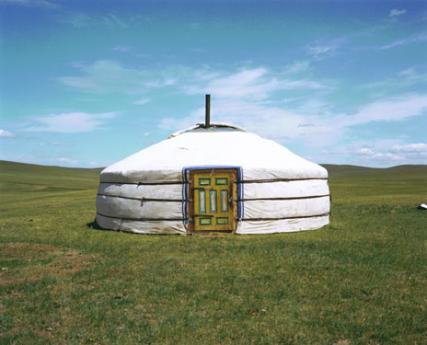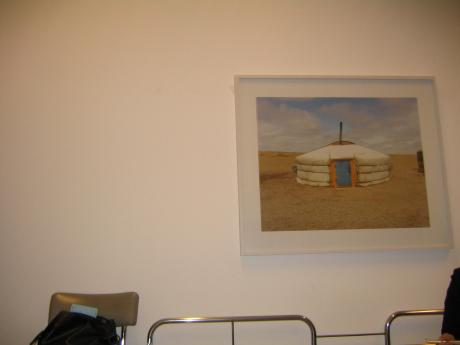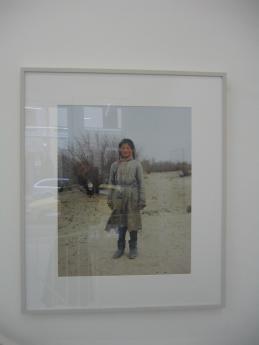METTE TRONVOLL
/
MONGOLIA
08.11. – 22.12.2007
Auch in ihren neuen Bildern stellt uns Mette Tronvoll Menschen aus der Peripherie gegenüber. Mongolische Mütter, Eheleute, Kinder und Jugendliche. Sie positionieren sich in heimatlicher Landschaft vor einem weiten, unverstelltem Horizont frontal zur Kamera. Unberührte Steppen und Berge bilden eine arkadische Folie für verwehte Mythen, die von romantischer Freiheit und heroischen Eroberungszügen erzählen. In ihrer unberührten Naturschönheit festgehalten werden sie zu Wunschbildern eines abgelegenen Ortes, der fernab unserer Zentren und unseres Zeitbegriffs liegt.
Die Mongolei, immer ein eigenständiger Staat mit nomadisierenden Staatsbürgern, die ihre Gers (Jurten) aufstellen wie zu Zeiten Djenghis Khans, war im 20. Jahrhundert geopolitisch zwischen den Supermächten der Volksrepublik China und der ehemaligen UDSSR eingeschlossen. Von beiden zwar abwechselnd beeinflusst, hat das Land doch seine Identität dauerhaft bewahren können
Stilistisch sind ihre Bilder statisch gebaut und zeigen keine Schnappschüsse. Zudem sind sie situativ und vermeiden das Narrative. Ob sie nun Einzelporträts alter und junger Frauen einander gegenüberstellt, wie in der Werkgruppe Age (1994), oder ob sie wie in Double Portraits (1998) zwei nahezu identische, kurz nacheinander geschossene Aufnahmen von ein und derselben Person nebeneinander präsentiert, ihr Thema umkreist immer wieder das Zeitliche. Mit den Einzel- und Gruppenporträts von Badenden in Grönland, Isortoq Unartoq (1999), überträgt sie dieses Thema auf subtile Weise. Auch hier in der Bilderserie aus der Mongolei versteht sie es, den Raum im Mythologischen aufzulösen und die Figuren und die Gers wie in Stein gehauene Büsten wirken zu lassen. Hier entschwindet das Zeitliche ins Ewige und wird durch die anwesenden Spuren der Zivilisation gleichwohl ins Zeitliche zurückgeholt.
In her new series, Mette Tronvoll again confronts us with people from the periphery: Mongolian horsemen, fighters, mothers, married couples, children, and youths. Set in their native landscape against a wide, unobstructed horizon, they face the camera directly. The steppes and mountains behind them are almost Arcadian, a backdrop for half-forgotten myths that speak of romantic freedom and heroic conquests. Thus preserved in their untouched natural surroundings, the figures become idealized images of remoteness, far from our urban centers and our grasp of time.
Mongolia has always been an independent state, but in the twentieth century it found itself geopolitically hemmed in by two superpowers: the People’s Republic of China and the former USSR. Although alternately influenced by both, the country continually managed to preserve its own identity. Its nomadic citizens still set up their gers as they did in the days of Djenghis Khan, still gird their jackets against the wind and cold as they have since time immemorial.
Stylistically, these are static compositions with nothing of the snapshot about them. They are situational and avoid narrative. Her theme always revolves around the temporal, whether she contrasts individual portraits of older and younger women as in the series Age (1994) or, as in Double Portraits (1998), presents side-by-side two almost identical photos of the same person, taken in quick succession. In her individual and group portraits of bathers on the island of Unartoq, Greenland, of 1999, she subtly evokes the same theme. And here, too, in the series of images from Mongolia, she understands how to dissolve space into the mythological, allowing the figures and the gers to seem like busts carved from stone. The temporal vanishes into the eternal, only to be brought back to itself through those manifest traces of global civilization.
Mette Tronvoll ( → Artist Website)
/
Biography
Solo Exhibitions
BGE Contemporary, Stavanger
“Portretter” / Dropsfabrikken, Trondheim
Nuuk kunstmueum, Nuuk
Nanortalik museum, Nanortalik
Qaqortoq museum, Qaqortoq
Nasjonalgalleriet / Oslo
"Sonja. Porträts der norwegischen Königin" / Nordische Botschaften, Berlin
Hallingdal Museum, Nesbyen
Lågdalsmuseet, Kongsberg
"Auf Augenhöhe / Haus am Waldsee, Berlin
"Rena 006 + Goto Fukue" / Galleri K, Oslo
Gallery Benoit, Boston, USA
Rogaland kunstmuseum, Stavanger;
Bergen kunstmuseum, Bergen;
v Landesgalerie am Oberösterreichische Landesmuseum, Linz;
Haus am Waldsee, Berlin;
Brandts Museet for Fotokunst, Odense
"Rena 006" / Fotogallerie, Oslo
Kunstnernes Hus, Oslo
SK Stiftung Kultur, Köln
Trondheim Museum, Trondheim
Christianssands Kunstforening, mit Eline Mugaas, Kristiansand
Galerie Max Hetzler, Berlin
Staatliche Kunsthalle Baden-Baden, Baden-Baden;
Künstlerhaus Bethanien, Berlin;
Nordjyllands Kunstmuseum, Aalborg;
Museet For Samtidskunst, Oslo
Murray Guy, New York
Förderkoje, Art Cologne, Murray Guy
Group Exhibitions
"Hjem" / SKMU Sørlandets kunstmuseum, Kristiansand
"Now is the time", 25 Jahre Sammlung Kunstmuseum Wolfsburg, Wolfsburg
10 Years of MKdW – Contemporary / Museum Kunst der Westküste, Föhr
“25-åringen” / Stavanger kunstmuseum, Stavanger
“Crossroads” / Lillehammer kunstmuseum, Lillehammer
“Fattig kunst - rik arv. Arte Povera og parallelle praksiser 1968-2015” / Nasjonalmuseet, Museet for Samtidskunst
“Tech 4 Change - Statoil Art Programme” / Vestfossen kunstlaboratorium, Vestfossen
“In a lonely place” / Kunstmuseet KUBE, Ålesund
"Forms of Freedom. African Independence and Nordic Models" / Den nordiske paviljongen, Arkitekturbiennalen i Venezia, Venezia
"Inexhaustible Beauty - uendelig skjønnhet", SpareBank 1 Nord-Norge - Kunststiftelsen / Galleri NordNorge, Harstad
“Crossroads” / Drammen Kunstmuseum, Drammen
"Heimat/ Home"/ DZ Bank Art Collection, Kunsthalle HGN, Duderstadt
"AUF DIE PLÄTZE." / Deutsches Hygiene-Museum, Dresden
"WELT - BILDER 4 / WORLD IMAGES 4" / Helmhaus Zürich, Zürich
“Goddesses” / Nasjonalmuseet for kunst, arkitektur og design, Oslo
"Gescheiterte Hoffnung, Neue Romantik in der zeitgenössischen Fotografie in Deutschland" / The Brno House of Art, Brno, Tschechische Republik
"EAST WEST FUSION Pt. 1" / Norwegian Views on Japan, HOLE artcenter, Krokkleiva, Norwegen
“ZEIGEN” / Temporäre Kunsthalle Berlin, Berlin
"Gescheiterte Hoffnung. Romantik heute?" / Herbert Gerisch Stiftung, Neumünster
"Unterholz" / Din A4 Projekte Atelier Berlin, Berlin
“Sett og registrert. Fotografi fra samlingen 1950–2007” / Nasjonalmuseet for kunst, arkitektur og design, Oslo
“Traces of Siamese Smile: Art + Faith + Politics + Love” / Bangkok Art and Culture Center, Bangkok
“Vietnam-Hanoi-Berlin”/ Ryllega Berlin: Glaspavillion an der Volksbühne Berlin
“Mørkeromsbilder - Bjørka 10 år” / Preus Fotomuseum, Horten
“European Eyes on Japan/ Japan Today vol.10” / John Humble Gallery Contemporary Urban Centre(CUC): North West, Liverpool
“Kunst fra 100 rom – verk fra Universitetet i Oslos kunstsamling”/ Henie Onstad kunstsenter, Oslo
"A Glimpse of the Collection / Contemporary Portrait Photography" / SK Stiftung Kultur at Art Cologne, Köln
"Failed Hope-New Romanticism in Contemporary Photography in Germany" / Goetz Palace, Krakau
"Royal Caribbean Arts Grant-5 years anniversary" / Kunstnernes Hus
"Huellas" / Senda-Espai2nou2, Barcelona
2. Fotofestival Mannheim-Ludwigshafen-Heidelberg - Städtische Kunsthalle Mannheim, Mannheim
“Clusters”, Nordea Art Collection / Henie Onstad kunstsenter, Oslo
“Modern Norwegian Art Photography” / Stenersen museet, Oslo
"Artist Migration Berlin" / Dellbrügge & De Moll / Heidelberger Kunstverein, Heidelberg
Temporary Art Museum Soi Sabai, kuratiert von Fumiya Sawa, Bangkok
"Symbolsk Orden" / Stravanger Kunstmuseum, Stravanger
"Artist Migration" / Dellbrügge & de Moll, Kunstverein Heidelberg, Heidelberg
Central Exhibition Paris Photo, Carrousel du Louvre, Paris
"Dschingis Khan und seine Erben. Das Weltreich der Mongolen" / Wien / Istanbul
Granship, Shizuoka city
Bodajima City Museum, Niigata
The Yamanashi Prefectural Museum of Art, Yamanashi
"Dschingis Khan und seine Erben. Das Weltreich der Mongolen" / Kunst- und Ausstellungshalle der Bundesrepublik Deutschland, Bonn
Staatliches Museum für Völkerkunde, München
"Symbolsk Orden" / Trondheim Kunstmuseum, Trondheim
"Temporary Import" / Art Forum Berlin, kuratiert von Susanne Titz, Berlin
"Two Asias, two Europes" / Shanghai Duolun Museum of Modern Art, Shanghai Endelig Hjemme, Riksutstillinger/ Stenersenmuseet, Oslo
"In a Norwegian Wood" / The Zacheta Gallery of Contemporary Art, Warschau
“my room somehow somewhere”, curated by Fumiya Sawa, Graf, Osaka Room Air / IT PARK Gallery, Taipei, Taiwan
“Beyond Paradise” / Fine Art Museum, Shanghai (catalogue) “storebrand@stenersen” / Stenersenmuseet, Oslo
“Himmel & Helvete”, Kistefos-museet, Jevnaker (catalogue)
"Lila, weiß und andere Farben - A Summer Group Show" / Galerie Max Hetzler, Berlin
"Spread In Prato" / HISK - Higher Institute for Fine Arts, Gent
"Spread In Prato" / Dryphoto Arte contemporanea, Prato
"About Face" / Yancey Richardson Gallery, New York
“tell it like it is” / Galerie Volker Diehl, Berlin
“Portrait” / Lindig in Paludetto, Nürnberg
“The Promise of Photography”, From the collection of the DZ BANK / Schirn Kunsthalle Frankfurt, Frankfurt am Main; Salle du musée du Botanique, Brüssel
“Kjærleikens ferjereiser” / Kunstfestivalen i Lofoten, Svolvær
“Ars 01” / Museum of Contemporary Art KIASMA, Helsinki (catalogue)
“Kunst und Kur-Ästhetik der Erholung” / Kunst Meran, Meran (catalogue)
“Grønland som billede” 7 Det Nationale Fotomuseum, København
“The Conversation” / Murray Guy, New York
“Andres Verk" / The National Museum of Contemporary Art, Oslo
Museum der bildenden Künste, Leipzig
“face-á-face” / Kunstpanorama Luzern, Luzern
“Collectors Choice”, Exit Art, New York
“Samfunnsengasjement, politikk og hverdag 70/90, Samlingen i perspektiv1” / Museet for Samtidskunst, Oslo
“Vis à vis” / UKS, Oslo
“Konstruksjon eller virkelighet” / Lillehammer Kunstmuseum, Lillehammer
Nordnorsk Kunstmuseum, Tromsø
“80/90, Mirrors of our Time” / Listasafn Islands, Reykjavik; Contemporary Art Center, Vilnius
“Jeanne d’Arc" / Sørlandets Kunstmuseum, Kristiansand; Nordenfjeldske Kunstindustrimuseum, Trondheim; Vestlandske Kunstindustrimuseum, Bergen; Nordnorsk Kunstmuseum, Tromsø
“25th Anniversary: 25 Younger Artists” / John Weber Gallery, New York
“Portrett" / Museet for Samtidskunst, Oslo
Janice Guy, New York
“Desemberutstillingen” / Trondheim Kunstmuseum, Trondheim



